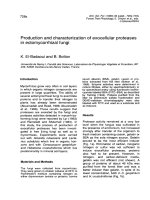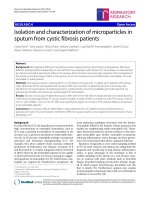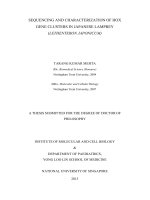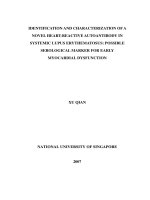Assessment and characterization of soil in Sarguja district, Chhattisgarh, India
Bạn đang xem bản rút gọn của tài liệu. Xem và tải ngay bản đầy đủ của tài liệu tại đây (328.68 KB, 7 trang )
Int.J.Curr.Microbiol.App.Sci (2017) 6(7): 223-229
International Journal of Current Microbiology and Applied Sciences
ISSN: 2319-7706 Volume 6 Number 7 (2017) pp. 223-229
Journal homepage:
Original Research Article
/>
Assessment and Characterization of Soil in Sarguja District,
Chhattisgarh, India
Sunny Abhishek Tigga*, Tarence Thomas, Arun A. David,
Narendra Swaroop and P. Smriti Rao
Department of Soil Science and Agricultural Chemistry, Sam Higginbottom University of
Agriculture, Technology and Sciences- Allahabad 211007, U.P., India
*Corresponding author
ABSTRACT
Keywords
District, Block,
Villages, Soil,
Depths, Nutrients
etc.
Article Info
Accepted:
04 June 2017
Available Online:
10 July 2017
An investigation was carried out to study the soil properties of Sarguja District.
The main objective of this study is to collect information on soil pH, electrical
conductivity, organic carbon, trance element N, P, K, Zn, and S. With the help of
this study we found the value of pH is found varied from 6.9 to 6.08. It is slightly
acidic in nature. The EC value is varied from 0.335 to 0.142 and it is normal. The
value of OC% found is varied from 0.78% to 0.12% and this is low to medium
level. The value of available nitrogen (kg ha-1) found is varied from 264 kg ha-1 to
173.4kg ha-1 and this is low level. The value of available phosphorus (kg ha-1)
found is varied from 25.4 kg ha-1 to 10.5 kg ha-1 and this is low level. The value of
available potassium (kg ha-1) found is varied from 110.4 kg ha-1 to 138 kg ha-1 and
this is low level. The value of available sulphur (ppm) is found varied from 18.5
ppm to 9.6 ppm and this is low to medium level. The value of available zinc (ppm)
is found varied from 1.62 ppm to 0.8 ppm and this is medium to high level.
Introduction
Soil as important part of the ecosystems
which must be protected in the environment
context and it is necessary to be studied the
possible overall impact of measures for
protection. The soil resource occupies a
fundamental part of the ecosystem when a soil
is degraded the others components of the
ecosystems are degraded too (Robles et al.,
2014).
animal are depends on Agriculture and allied
per suits, based on exploration of the soil
resources. Further, the varieties of industrial
products are also dependent on farm and
forest products directly derived from the soil
Familiarity with the potentiality of soil,
knowledge of their limitation and their use
and method of management of soil without
deterioration are important for sustained
production. It is further important to bring the
deteriorated land in the use after due
reclamation. Knowledge of such kinds of soil
and their extent is important for proper
planning and optimum use for maximization
Soils are most valuable natural resources on
which the agriculture production is based. The
production of food, fodder, and fuel to fulfill
the ever growing needs of human being and
223
Int.J.Curr.Microbiol.App.Sci (2017) 6(7): 223-229
for agriculture production. Soil survey is the
only tool for making the inventory of soils
(Upadhyay et al., 2014).
South and South East, Maharashtra in South
West and Madhya Pradesh in the West. Paddy
is the main crop of the state and due to
abundance of production of paddy
Chhattisgarh was known as ‘Rice Bowl of
Central India.’
Soil is the basic resource for agriculture and
its proper management is essential to sustain
agricultural production and maintain soil
productivity. Soil testing is one of the best
available tools, to ascertain the physical
characteristics and nutrient status of a field so
as to assess the fertilizer requirements for a
crop or a cropping system or for knowing the
reclamation requirements if the soil is
saline/sodic in nature.
A vast region of Chhattisgarh is covered by
red and yellow soil. There are a number of
types of soil found in Chhattisgarh area but
there are four major types namely Kanhar,
Matasi, Dorsa and Bhata, which cover major
portion of the total land area. The red color of
soil is generally related to unhydrated ferric
oxide, and partially hydrated ions oxides. The
yellow color in soil is also due to oxides of
iron. The soils of the region are deficient in
important mineral nutrients like nitrogen,
phosphorous, lime and potash, which are
concentrated in the lower parts of the soil
layer. However, the tropical red and yellow
soils or the red sandy soils of the region
possess texture suitable for growing crops.
For the state as a whole, the predominant soil
type is red and yellow loamy Soil. The
percolation/water retention capacity, as well
as the productive capacity of different soils,
varies. The following types of soils are found
in Chhattisgarh:
Fertilizer application based on soil tests is the
best available approach for harvesting the
economically viable potential yields of crops
by increasing input use efficiency and
maintaining soil health (Singh and Brar,
2005). The production of rice crop is more in
the Central part of India. Chhattisgarh is
situated in the central part of India. The state
of Chhattisgarh, with Raipur as its capital,
came into existence on 1st November, 2000
by separation of 16 districts of Chhattisgarh
region from Madhya Pradesh. At present 27
districts
are
there
in
Chhattisgarh.
Chhattisgarh is situated between 22.0078°N
latitude and 83.3362°E longitude in Central
eastern part of India. The total geographical
area of the state is 136.03 thousand sq. km.
Kanhar (clayey)
A low-lying deep bluish black soil with high
moisture retention capacity. It is well suited
for rabi crops, particularly wheat.
Geographically, Chhattisgarh is divided into
three distinct land areas viz.
Chhattisgarh Plains,
Bastar Plateau and
Northern Hill Zones.
Matasi (sandy loamy)
This is a yellow sandy soil, with an admixture
of clay. It has limited moisture retention
capacity. Though used for paddy.
The state receives annual rainfall ranging
from less than 1200 mm to greater than 1600
mm in different areas. The border of
Chhattisgarh is touched by the states Uttar
Pradesh in the North, Bihar in the North East,
Orissa in the East, Andhra Pradesh in the
Dorsa (clay-loam)
This type of soil is intermediate in terms of
soil moisture retention between kanhar and
224
Int.J.Curr.Microbiol.App.Sci (2017) 6(7): 223-229
matasi. This is best described as loamy, and is
a color between brown and yellow.
beyond Sonhat to above a height of 1,033
metres (3,389 ft). Central Surguja is a low
basin through which the Rihand and its
tributaries flow.
Bhata (laterite)
This soil is a coarse-textured, red sandygravelly soil, found on upland tops. It is
deficient in minerals and other productivity
enhancing nutrients.
The pH was determined in 1:2 soil water
suspensions using Digital pH Meter (Jackson
1958). The EC was determined in 1:2 soil
water suspensions using Digital Conductivity
Meter (Wilcox 1950).The organic carbon was
determined by Rapid Titration Method
(Walkley, 1947). Available nitrogen is a term
used to describe the fertilizers. The available
N <250 kg ha-1 may be interpreted as low,
250-500 kg ha-1 as medium and >500 kg ha-1
as high.
Materials and Methods
The present study was conducted in three
stages i.e. soil survey and mapping, collection
of samples and their analysis for different soil
parameters. The soil samples were collected
from 2 blocks viz., Ambikapur and Batauli of
Sarguja district (C.G) (Fig. 1). From
Ambikapur block 4 villages Sakalo, Sargava,
Mendrakhurd, Digma and from Batauli block
5 villages Deaori, Basen, Kunkuri, Batauli,
Bhatko were selected. 27 samples were
collected with different depths (0-15cm, 1530cm and 30-45cm). Statistical analysis was
done using standard analysis of variance. It
lies between 22.9494°N latitude and 83.1649°
E longitude. 244.62 kilometres long east to
west and 67.37 kilometres broad north to
south, this land has as area of about 16,359
square kilometres. The high-lands of Surguja
district have peculiar 'pat formations' highlands with small tablelands. The Mainpat,
the Jarang pat, the Jonka pat, the Jamira pat
and the Lahsunpat are the major parts of the
district. The average height of area is above
600 metres (2,000 ft). Some of peaks are Mailan 1,226 metres (4,022 ft), Jam 1,166
metres (3,825 ft), Parta Gharsa 1,159 metres
(3,802 ft), Kanda Dara 1,149 metres
(3,770 ft), Chutai 1,131 metres (3,711 ft), and
Karo 1,105 metres (3,625 ft). There are a
number of other peaks. North–west Surguja is
hilly in nature, and moving westwards, three
distinct steps may be marked out: the first
from Shrinagar on the east to the low-lands of
Patna and Kharsawan, the second from thence
to the uplands around Sonhat and the third
The soil was distilled with alkaline potassium
permanganate as suggested by (Subbiah and
Asija, 1956) and the ammonia evolved was
determined. The available phosphorous was
extracted from soil by 0.5 M NaHCO3 (pH
8.5) solution. Phosphorous in the soil extract
is determined colorimetrically using a
Photoelectric Colorimeter after developing
molybdenum blue colour (Olsen et al., 1954).
The exchangeable potassium is extracted from
1N NH4OAc (pH 7.0) and K was determined
by Flame Photometer (Toth and Prince,
1949). The zinc was determined by (Shaw
and Dean, 1952; Holmes, 1945).The sulphur
was determined by (Bardsley and Lancaster,
1960).
Results and Discussion
The observations regarding pH, EC, Organic
carbon, Nitrogen, Phosphorus, Potassium
extracted from soil are given in figures 2 to 4
and on table 1. The figure 2 depicts the
statistical accumulation of pH on villages and
depth which was found to be significant at
both levels. The highest value of pH is found
in Digma village at depth 0-15cm (6.9). The
figure 3 depicts the statistical accumulation of
EC on villages and depth which was found to
be significant at both levels. The highest
225
Int.J.Curr.Microbiol.App.Sci (2017) 6(7): 223-229
value of EC is found in Batauli village at
depth 0-15cm (0.335). The figure 4 depicts
the statistical accumulation of organic carbon
on villages and depth which was found to be
significant at both levels.
significant at both levels. The highest value of
phosphorus is found in Digma village at depth
0-15cm (25.4 kgha-1).The accumulation of
available potassium on villages and depth
which was found to be significant at both
levels. The highest value of potassium is
found in Deaori village at depth 0-15cm
(210.4 kgha-1). The accumulation of available
sulphur on villages and the depth which was
found are to be significant at both levels. The
highest value of sulphur is found in Sargava
village at depth 0-15cm (18.5 ppm).The
highest value of zinc is found in Batauli
village at depth 0-15cm (1.62 ppm).
The highest value of organic carbon is found
in Mendrakhurd village at depth 0-15cm
(0.78%). The accumulation of available
nitrogen on villages and the depth which was
found are to be significant at both levels. The
highest value of nitrogen is found in Sargava
village at depth 0-15cm (264 kgha-1).The
accumulation of available phosphorus on
villages and depth which was found to be
Table.1 Available NPK, Zn and S in soil of Sarguja District, Chhattisgarh, India
S.No.
Villages with different
depths
1.
2.
3.
4.
5.
6.
7.
8.
9.
10.
11.
12.
13.
14.
15.
16.
17.
18.
19.
20.
21.
22.
Is
24.
25.
26.
27.
Digma (0-15cm)
Digma (15-30cm)
Digma (30-45cm)
Deaori (0-15cm)
Deaori (15-30cm)
Deaori (30-45cm)
Sakalo (0-15cm)
Sakalo (15-30cm)
Sakalo (30-45cm)
Sargava (0-15cm)
Sargava (15-30cm)
Sargava (30-45cm)
Mendrakhurd (0-15cm)
Mendrakhurd (15-30cm)
Mendrakhurd (30-45cm)
Kunkuri (0-15cm)
Kunkuri (15-30cm)
Kunkuri (30-45cm)
Basen (0-15cm)
Basen (15-30cm)
Basen (30-45cm)
Bhatko (0-15cm)
Bhatko (15-30cm)
Bhatko (30-45cm)
Batauli (0-15cm)
Batauli (15-30cm)
Batauli (30-45cm)
Available
nitrogen
(kg ha-1)
212.4
210
198.5
234.1
212.1
186.2
207.6
184.1
173.4
264
255
201.8
240
209.6
205.4
260
205.4
174
234
219.2
215
210.5
201
198.5
262
230
205.6
Available
phosphorus
(kg ha-1)
25.4
18.5
16.1
23.1
16.7
13.8
14.1
11.3
11.7
16.2
15.2
10.5
17.9
16.1
14.3
22.6
15.9
14.7
18.4
16.8
14.4
15.8
15.2
13.4
18.7
18.5
13.6
226
Available
potassium
(kg ha-1)
194.7
188
163
210.4
198.7
174.7
180.5
175.7
168.2
210
204.1
173.7
185.7
164
138
195.7
180.5
178.2
194.1
189.5
186
210.1
189
172.8
201
198.1
174.8
Available
zinc
(ppm)
1.4
1.16
0.98
1.48
1.3
0.92
1.2
1.18
0.92
1.4
1.3
0.84
1.32
1.14
0.95
1.15
1.1
0.9
1.18
0.94
0.8
1.05
0.9
0.84
1.62
1.05
0.84
Available
sulphur
(ppm)
15.6
13.3
10.2
12.7
11.4
10.3
14.9
11.7
13.7
18.5
14.1
13.2
14.8
11.9
10.8
15.1
13.8
9.6
13.4
11.7
10.1
16.2
14.6
13.1
15.7
14.5
10.6
Int.J.Curr.Microbiol.App.Sci (2017) 6(7): 223-229
Fig.1 Map of Sarguja districts
Source:-httpwww.nrcddp.orgresources_dataDld100016.jpg
Study site
Fig.2 pH values of soil of Sarguja district, Chhattisgarh at
(0-15cm, 15-30cm, 30-45cm) depths, 2017
227
Int.J.Curr.Microbiol.App.Sci (2017) 6(7): 223-229
Fig.3 EC (dSm-1) values of soil of Sarguja district, Chhattisgarh at
(0-15cm, 15-30cm, 30-45cm) depths, 2017
Fig.4 OC (%) values of soil of Sarguja district, Chhattisgarh at
(0-15cm, 15-30cm and 30-45 cm) depths, 2017
potassium (kg ha-1) found is varied from
110.4 kg ha-1 to 138 kg ha-1and this is low
level. The value of available sulphur (ppm) is
found varied from 18.5 ppm to 9.6 ppm and
this is low to medium level. The value of
available zinc (ppm) is found varied from
1.62 ppm to 0.8 ppm and this is medium to
high level.
It is concluded that the soil of Ambikapur and
Batauli Block in Sarguja District of
Chhattisgarh showed status according to
figure 2 the value of pH is found varied from
6.9 to 6.08. It is slightly acidic in nature. The
EC value is varied from 0.335 to 0.142 and it
is normal similarly result found (Upadhyay et
al., 2014). The value of OC (%) found is
varied from 0.78% to 0.12% and this is low to
medium level. The value of available nitrogen
(kgha-1) found is varied from 264 kg ha-1 to
173.4kg ha-1 and this is low level. The value
of available phosphorus (kg ha-1) found is
varied from 25.4 kg ha-1 to 10.5 kg ha-1 and
this is low level. The value of available
Acknowledgement
Authors are sincerely thankful to Dr. T.
Thomas Head and Associate Prof., Dr.
Narendra Swaroop, Associate prof., Dr. A. A
David, Associate Prof. Department of Soil
228
Int.J.Curr.Microbiol.App.Sci (2017) 6(7): 223-229
Science and Agricultural Chemistry of Naini
agricultural institute SHUATS Allahabad
(U.P).
and development3(7) 34-38.
Shaw, E. and Dean, L.A. (1952). The use of
dithizone as an extractant to estimation
the nutrient status of soil. Soil Sci.73
341-344.
Singh, M., and Brar J.S. (2005). The physicochemical characteristics and fertility
status of soil of Amritsar district of
Punjab, J. Res. Punjab agric. Univ. 42
(1) 19-27.
Subbiah B. V. and Asija C.L. (1956). A rapid
procedure for the estimation of
available nitrogen in soil, Current
Sci.25 259-260.
Toth, S. J. and Prince, A.L. (1949).
Estimation of cation exchange capacity
and exchangeable Ca K and Na Content
of Soil by Flame photometer technique.
Soil Sci.67 439-445.
Upadhyay, M. and Chawla J. K. (2014)
Chemical characteristics of soil in parts
of Dhamtari District of Chhattisgarh.
IJMCA, 4(13) 146-149.
Walkley, A. (1947). Critical examination of
rapid method for determining organic
carbon in soil, effect of variation in
digestion condition and of inorganic soil
constitutes. Soil Sci.632-251
Wilcox, L.V. (1950).Electrical conductivity,
Amer. water works assoc. J. 42 775-776
References
Bardsley, C.E. and Lancaster, J.D.
(1960).Determination of reserve sulphur
and soluble sulphates in soil. Soil Sci.
Soc. Amer. Proc. 24 265- 268
Holmes, R. S. (1945). Determination of total
copper, zinc, cobalt, lead in soil and
Soil solution, Soil Sci.59 77-84.
Jackson, M.L. (1958).Soil Chemical Analysis,
Prentice Hall of India Private Limited,
New Delhi.
Olsen, S.R., Cole, C.V., Watnahe, F.S. and
Dean L.A. (1954). Estimation of
available phosphorous in soil by
extraction with sodium bicarbonate U.S.
Dept. Agr. Cric. 939.
Pandey, A., Laxmi, R., Tiwari, J. and Sharma,
R. P., (2013). Distribution of available
macro and micronutrients in soils of
Dewas District of Madhya Pradesh A
Journal of multidisciplinary advance
research, 2(2) 108- 114.
Rao, P. S., Thomas, T., Singh Z. and Rachana
(2016).Assessment of macronutrients in
soils of Bastar Plateau Region,
Chhattisgarh,
India,
International
journal of multidisciplinary research
How to cite this article:
Sunny Abhishek Tigga, Tarence Thomas, Arun A. David, Narendra Swaroop and Smriti Rao,
P. 2017. Assessment and Characterization of Soil in Sarguja District, Chhattisgarh, India.
Int.J.Curr.Microbiol.App.Sci. 6(7): 223-229. doi: />
229









